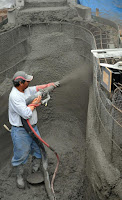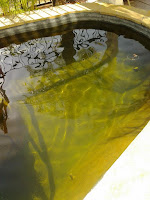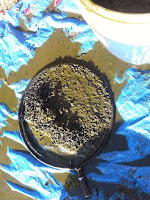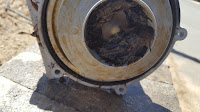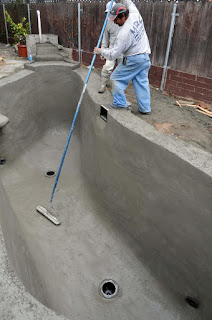 |
| Crazy troweling bottom of pond for a proper smooth surface for sealing |
Pool plaster is the final coating applied to the shell of a concrete in-ground pool. The layer of plaster is normally 1/4 inch to 1/2 inch thick. White is most common, but it can be tinted to other colors by using pigmented aggregate. Pool plaster adds a watertight seal and makes the surface of the pool smoother for contact with swimmers than the underlying rough concrete shell. It's also instrumental in creating a pleasing aesthetic appearance. Depending on Pond Maintenance or pool maintenance, a plaster coat may last up to seven years before re-plastering is required. Not good if you have a lot of Koi and need to drain pond to do crack repairs.
The ingredients of pool plaster mix are a 1-2 ratio of white portland cement with an aggregate that may be marble dust, limestone, or quartz sand. During the mixing process, these ingredients are frequently combined with a liquid acrylic concrete fortifier to increase underwater durability in the immersed conditions of a pool.
The appearance and expected service life of pool plaster can be affected by water chemistry. A low pH acidic condition can etch plaster, creating a rough, pitted surface that degrades faster. High pH, alkaline water causes calcium deposits called scaling to form, eventually discoloring the plaster. High levels of iron, copper or other minerals in the fill water will cause stains, and frequent acid washing due to algae issues deteriorates plaster. Most Koi ponds pH ranges from 7.2 to 8.9 depending on water district you're in. As ponds pH will balance out at 0.5 point plus or minus of tap water pH as a rule. It also depends on alkalinity reserve as to if pH stays stable. How often you do water changes,routine maintenances steps.
 |
| Poorly applied plaster coat |
 |
| Proper application of plaster, clean and tight. |
Many installers use additives like Xypex, which are great. These compounds form crystalline structures that can fill small cracks and voids and “self-seal” as the concrete separates. This works well to a certain point, if the soil isn’t solid/compacted properly enough, has a lot of clay in it, causing it to expand and contract, or is extremely sandy and moves a bit, and in this case hillside movement as seen below and the cracks become unmanageable. In this case it would be best to underpin/pin concrete with rebar to help keep from shifting side to side. A rubberized coating or polyurea would be the better/best choice to allow some flexibility. Other factors that can cause concrete to crack is colder climates the freeze/thaw cycle can/will break concrete up over time, and in areas with a high water table, concrete can be broken up as the ground shifts. In this case Xypex will not do what it is designed to do.
We have been involved with concrete in some form or another for close to 45 years now, starting in the trenches per say at 15. One of the key things when doing shotcrete is the Pumper and the Nozzle Operator I can not emphasize this enough! Most shotcrete projects start early and it can be long day, nonstop depending on yards of mud used. Your pumper is the key in keeping trucks rolling in as one empty rolls out thus keeping the flow of operation going smoothly. If there is too much time in between the concrete in hose can start to clog line thus cause time consuming clearing. One important thing is the pumper needs to understand proper slumps, adding water if needed to keep load at the right mix to nozzle operator. To wet it will not stand up on wall fall down, or too dry which is harder to work with. NOTHING worse than to have a hose clog up and you have to beat with hammers to clear it or remove heavy hose section to clear it.......put a big damper on day! That can be prevented with a good pumper in charge that knows his business.
One trick to stacking up mud on a vertical wall is to use 1" dia chicken wire you will be surprised as to how much this helps. A good nozzle man can lay down a wall of mud just right for the finishers to come in and start to shave and shape wall, with final slick trowel finish. Finish crew is an important part of the sealing process prep. A pitted surface like below is not acceptable in my eyes just takes a few more minutes to slick troweled Vs. a knock down finish which is good for plaster. But when it come to epoxy or Polyurea or even rubberized products it is not.


This brand of epoxy uses two steps, primer coat first which bonds to most surfaces when prepared properly. Then the final finish coat of epoxy.
In a pond with a concrete collar and a dirt floor, a geotextile fabric is laid down over the dirt portions and attached to the collar and components with polyurea. This fabric is similar to the underlayment used with liner, but much smoother and stronger. Waterfalls can be built successfully with polyurea as well.
When planning a new pond build with concrete take a few extra steps in researching a pumper and finishing crew as they're not all the same believe me! If you need help feel free to contact us and we can help you plan your pond and connect you with experienced pumper and finish team.


